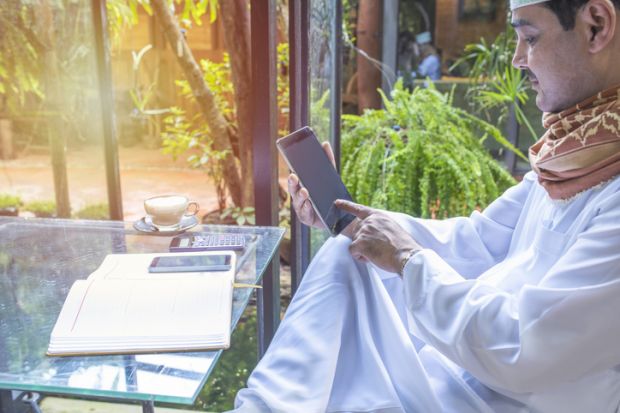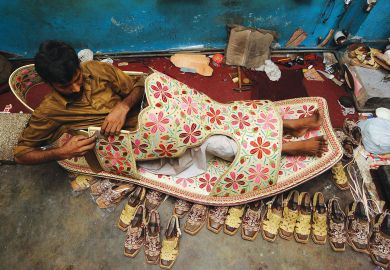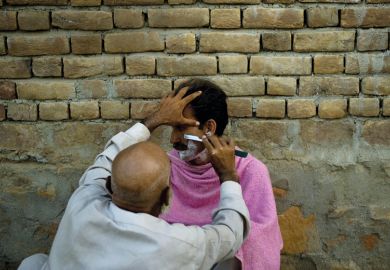Pakistan’s swift closure of university campuses before the coronavirus had claimed a single life in the country surprised many staff and students. But the problems that followed were all too predictable.
Mandating a sudden switch to online learning was always likely to be chaotic and cumbersome for staff because university teachers had not been trained to conduct lessons in this way. This problem was common to many countries, of course. But the difficulties of conducting digital teaching and learning in Pakistan are particularly stark.
The ministers and advisers who ordered the closure of the country’s campuses in mid-March probably did not foresee how their actions would highlight the yawning digital divide between students from urban and rural backgrounds. Many students lack digital proficiency, as well as the finances to buy reliable high-speed internet access; only 38 per cent of Pakistan’s population currently use broadband.
Indeed, many people in remote regions have no electricity, let alone internet access. As Lala Rukh, who lectures at the University of Swat in the mountainous Khyber Pakhtunkhwa province, put it to us: “Online learning for remote areas like Swat is like trying to make the fish learn to live without water.”
Sometimes the universities themselves lack sufficient resources to make a success of online teaching. “In some university institutes, we don’t even have enough chairs for every student in class,” Rukh says. “So going online and developing a digital infrastructure is challenging.” But there were also problems when students returned to remote villages or towns after the closure of relatively well-resourced metropolitan campuses.
Mehjabeen Hameed, assistant professor of botany at Sardar Bahadur Khan Women’s University, in the northern province of Baluchistan, told us that in some remote areas the unstable internet access was unable to support most of the online portals that universities use for teaching, such as Zoom. As women are more likely to stay closer to home for study, often in towns with poor internet connections, they have been disproportionately affected by these problems.
That neither faculty nor students were familiar with these platforms was another big problem, according to Mubasher Nazir, a lecturer at the University of the Punjab. And although teachers did their best to adapt to online teaching, many found the technology more suitable for simply sharing course materials or relaying formative feedback, rather than creating a truly interactive student-teacher experience.
Studying in shared family spaces or cramped living conditions also made it nearly impossible for many home learners to concentrate on their studies. And even when students were able to access good study environments with reliable internet connections, they struggled to engage with the basic systems used by their teachers.
Currently, in-person teaching has at least partly resumed in many Pakistani universities, and the country’s prime minister, Imran Khan, is adamant that the economic damage that would be wrought by a second lockdown is unthinkable. But some lecturers hope that the shift to remote learning, however rushed and imperfect, may leave a positive legacy.
“A major technological shift has happened in the lives of our educated people, who now use technology for arranging webinars and research meetings in a way that was totally unknown to most of our faculty in the recent past,” observes Muhammad Rizwan Riaz, an assistant professor in the department of civil engineering at the University of Engineering and Technology Lahore. “Now everyone will think that instead of calling an external examiner or expert from some other city or province, it is convenient to conduct an online meeting instead.”
The online shift may have far bigger benefits, too. If it focuses governmental attention – and, crucially, action – on the digital divide that it has exposed, the prospects of millions of people could be transformed through the pandemic and beyond, ensuring that no regions or sectors of society are left behind educationally.
Moreover, if the government invests in building national IT infrastructure and technological literacy, in universities and beyond, the result will be a more inclusive and less unequal society.
Abdur Rehman Cheema is a development practitioner based in Islamabad, and Mehvish Riaz is an assistant professor at the University of Engineering and Technology Lahore.
POSTSCRIPT:
Print headline: Pakistan’s digital divide
Register to continue
Why register?
- Registration is free and only takes a moment
- Once registered, you can read 3 articles a month
- Sign up for our newsletter
Subscribe
Or subscribe for unlimited access to:
- Unlimited access to news, views, insights & reviews
- Digital editions
- Digital access to THE’s university and college rankings analysis
Already registered or a current subscriber? Login








